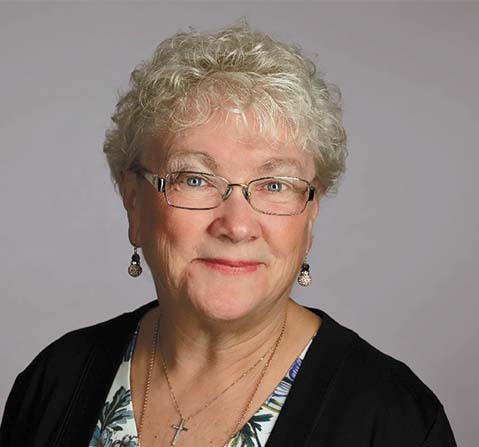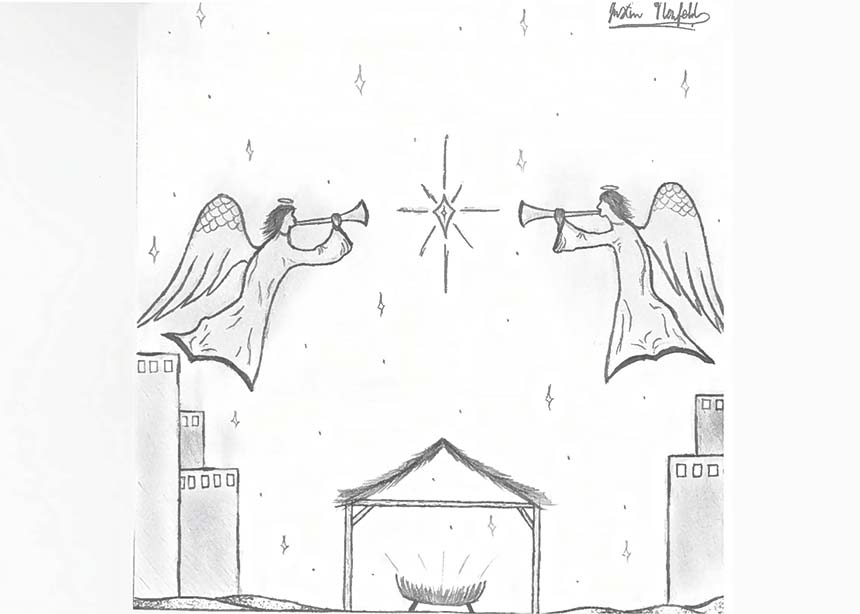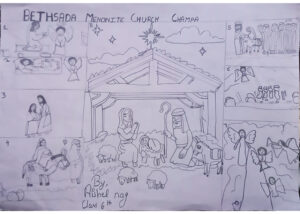Mary’s story comes to us this year, maybe in a new way, at a time when we welcome some really good news.
We could use an encouraging, empowering and heart-warming story right now.
Year after year in pageant, poetry and hymnody we rehearse Mary’s good news story and the angel’s message: “Fear not!” I confess that, in the past, I have imagined Mary’s song, her statements about God’s justice, as exclusively a call to bold action and loud resistance to the inequalities in society. Sometimes I have chastised myself for my nostalgia about the unlikely scene: Mary dressed in blue and white flowing robes, surprised by an angel’s sudden appearance yet somewhat meekly submitting to the divine request to birth God-come-among-us.
Yet this year I need the nostalgia, the warmth, the comfort, the safety that her story inspired in me as a child. Yes, it is the prelude to a dramatic salvation story, but this is also the affirmation, the comfort, that God is near to us, and that God’s purposes will be worked out in our lives because of the manger.
So, this year I regard myself a happy and grateful beneficiary of the blue-hued Mary, the bright yellow and white angel, the promises made and the chills of hope that these inspire. For now, we must hold on to the “Fear not” story in a way that both settles us yet also encourages us to take on the challenge that Mary presents.
Mary’s gratitude for God’s favour and protection is not original to her alone. This theme keeps coming around and around in the story of God’s people, Old Testament and New alike. Out of barrenness, trouble, despair or plain old ordinariness, God does a new and radical thing. God restores, upsets, undoes, reverses, creates. You never know for sure how God will make things right, turn things around.
Mary’s story
Once upon a time, there was a teenaged girl who lived in the ancient world of Palestine. She was an ordinary girl and already engaged to a man named Joseph.
Suddenly an angel appears and says, “Greetings, favoured one! The Lord is with you. . . . Do not be afraid, Mary, for you have found favour with God. And now, you will conceive in your womb and bear a son, and you will name him Jesus.” The angel continues: “He will be great, and will be called the Son of the Most High, and the Lord God will give to him the throne of his ancestor David. He will reign over the house of Jacob forever, and of this kingdom there will be no end.”
Mary is stunned. “How can this happen? This is not possible.” But the angel assures her that God will make it possible and that her son will be holy, and that he will be called Son of God. With that assurance Mary seems not to hesitate: “Here am I, the servant of the Lord. I am ready to do what God asks of me.”
It’s a story of possibility and the power of the word of God. It is the story of something new: new life, new relationship, unexpected mercy and whole-hearted trust. Mary confidently, and without hesitation, agrees to become a mother at God’s request and will carry to term and nurture the Son of God. Mary trusts that God will be with her through all of this, as she finds courage in the nearness of the Divine.
Mary’s story is a sign of encouragement for us also to take heart and be courageous. Yet this is a big ask right now, when there is a general feeling of anxiety in our lives. We’re living during a pandemic, with a “me first” mentality spreading through many places. Struggle is in the air. It seems that everywhere you turn, something threatening, frightening and unsettling lurks.
How do we stay safe when there is a raging disease in our midst and throughout the entire world? How do we resist succumbing to fear?
Politics and the manger
Most broadly defined, politics is about how we live together as a society, how we take care of the most vulnerable ones and how we share our resources. The truth is, we are living on a continent that is experiencing overt fearmongering. Conspiracy theories alarm us and make us afraid—on purpose. Anxiety is the order of the day.
At this time of pandemic distress, we see demonstrations under the guise of personal freedom: “No government can tell me what to do. They are taking away my freedom. Your health is not my responsibility.”
But we need to face some hard facts about the racist systems in our community and about our own racist tendencies. There are many people in our community who do not have the same access to safety because of the colour of their skin. These are some of the perplexing and complex issues dividing us in these anxious times. We have choices to make in response.
Mary’s choice would change the entire course of her life and of the world. She took on God’s challenge without fear and willingly because the Spirit of God would be present, and she would not be left alone. She trusted God. As her story continued to unfold, it became blatantly political, connected to the social issues at hand.
In the biblical tradition of making pronouncements about God’s “kin-dom,” about a politics that cares for all, Mary gave thanks for God’s presence and delivered a manifesto: “God has and will continue to scatter the proud, bring down the powerful from their thrones, lift up the lowly, fill the hungry with good things and send the rich away empty” (Luke 1:51-53).
Here is the justice part of the story: the part that goes along with the warm feelings of safety and security. The blue-hued Mary becomes the spokesperson for a new order, a new politics, a levelled-out society, a fairer way to live.
The political task then, as now, is one of cooperation rather than making threats and instilling fear in each other. There is such inequality over the face of the earth. God promises to turn things around, to raise the poor from subsistence living and starvation, and to lower the status and decrease the power of those who are thoughtless about the plight of so many. God will fill the stomachs and hearts of those left behind and give a hard stop to those who think that life is just about satisfying every personal desire.
This is part of Mary’s story, her call to justice, without fear. This becomes our story too, our inheritance. For the things of which Mary speaks are the very things that we hold dear as people of faith. Ours is the task of turning the world around. It is through us that God’s desire for equality is realized. Mary’s manifesto is for us to heed and to trust and to live into. And in this season of expectation and joy, it begins with “Fear not!”
We are bequeathed the ministry of calming anxiety instead of fanning flames of distress and division. Although we feel vulnerable, our faith tradition calls us to speak peace in a time of upset. We have Mary’s story to embolden us. God’s presence and mercy is promised as Luke reminds us, “to the descendants of Abraham forever.” The warmth of God’s presence, the warmth of the nativity scene is, for us, forever.
I happened upon a Facebook post that illustrates the simplicity of living in a kingdom of peace and mutuality. It is a quote from Pope Francis: “Living for others is a rule of nature. We are all born to help each other. No matter how difficult it is. . . . Life is good when you are happy, but much better when others are happy because of you.”
What an eloquent way of imagining a generous world. The idea of making others happy is a less harsh way of talking about levelling society and bringing down dictators. This can be a part of a peace-filled vision of Jesus’ birth.
The manger can be a uniting force. When we hold the Christmas story close and consider Mary’s story to be our inheritance, there is hope just around the corner. We can see joy and enough love to go around, even into the smallest corners of our world. There is a way forward without fear. This Christmastime, we can wait and anticipate and celebrate all at the same time. In this midst of a worldwide crisis, there is also joy and laughter and hope. The world is about to turn.
Prayer
God of the manger, you come to us this day with promises of steadfast love and presence. We come to you and accept that gift with warm hearts. For to the world has been born a Saviour, Jesus, our Lord, friend to all. May your Spirit of goodwill go with us now, carrying us into our Christmas celebrations, meeting our longing with joy and hope, so that we may be the force of love that turns the world around. Amen.
Anita Retzlaff attends Nutana Park Mennonite Church in Saskatoon. This is adapted from a sermon she preached there on Dec. 20, 2020, based on Luke 1:26-38;46-55.
The art accompanying this article came in response to an invitation for students to submit art on the theme: ‘The Christmas Story’.
For discussion
1. If you were preparing a Christmas pageant, what scenes would you include? Would you make the scenes feel warm and comfortable or dramatic and unsettling? How would you express comfort and how would you include the political part of Mary’s song?
2. Anita Retzlaff writes that Mary’s story is one of comfort, but it also calls us to courageously follow God’s calling. Why are many of us feeling particularly anxious at this time? What are the calls for justice that are present in our world? If we follow Mary’s example, what is our response to God’s call?
3. Retzlaff writes, “God restores, upsets, undoes, reverses, creates. You never know for sure how God will make things right, turn things around.” Can you think of examples from the last 20 years, or the last century, where God turned things around? How much do you think God influences what happens in the world? Are humans arrogant if they have a plan to solve the world’s problems?
4. What are the signs of joy and hope in Mary’s story? How does living without fear enable us to be generous and love others? Where do you see joy and hope in your life this Christmas season?
—By Barb Draper








Leave a Reply
You must be logged in to post a comment.